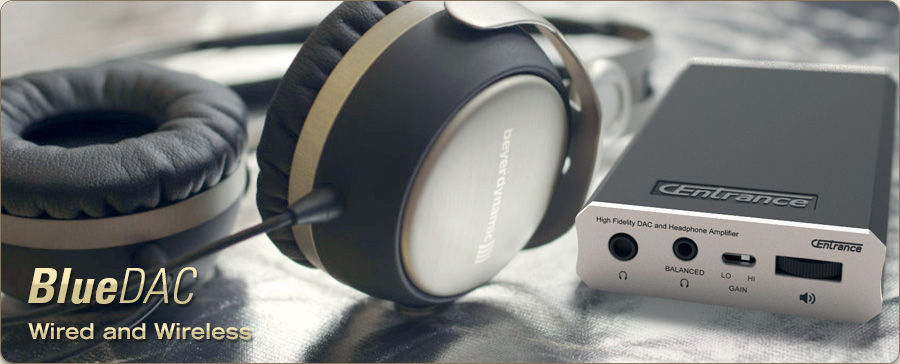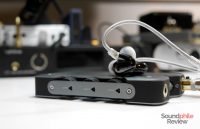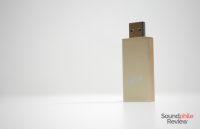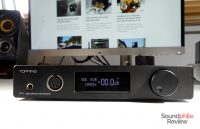CEntrance has announced a new entry in their portable line-up that mixes wireless with high-end audio: it’s the CEntrance BlueDAC, a Bluetooth DAC and amplifier. The company is looking for funds on Indiegogo and has already reached its goal with a month left.
The CEntrance BlueDAC is a product similar to the Creative SoundBlaster E5: it is a Bluetooth DAC which can also be used as a wired device to achieve the best quality. It supports files up to 384 kHz and DSD files when using the USB cord. The amp is capable of outputting up to 1000 mW of power from the 3.5 mm and 2.5 mm balanced jack outputs. There is a 20 dB gain switch to make sure even high impedance headphones play at reasonable volumes. The DAC chip is an AKM AK4490, while the USB controller chip is a XMOS U8. Supported headphones range from 16 Ω to 600 Ω and output impedance is just 1 Ω.
CEntrance claims the BlueDAC’s “proprietary circuitry upgrades the audio quality over the phone’s headphone jack, while removing cables.” While there is no doubt that the DAC and amp chips and the circuit design are light-years ahead of those found on phones, I doubt that using Bluetooth (even with apt-X as in this case) can lead to better quality. It will surely be one of the best Bluetooth-enabled DACs out there, though!
According to the estimates, the embedded battery should allow for up to 20 hours of playback. The outer shell is 3D printed in USA and is 110 x 57 x 18 mm.
The CEntrance BlueDAC is “sold” (even though crowdfunding is not about selling goods) starting at $329 on Indiegogo. Normal price when the campaign will be over will be $560, so a $230 discount is effectively applied. CEntrance’s site mentions a $459 MSRP, though, so it remains to be seen what the real price will be. Estimated delivery date is July 2017.









Thanks for the report on this.
You said, “While there is no doubt that the DAC and amp chips and the circuit design are light-years ahead of those found on phones, I doubt that using Bluetooth (even with apt-X as in this case) can lead to better quality. It will surely be one of the best Bluetooth-enabled DACs out there, though!”
That obviously depends on the quality of the phone’s built-in DAC and amp, as some are not very good, and some don’t include a headphone jack at all. I haven’t kept up to date with some of the Android phones and whether they’ve begun to use upgraded audio components or not.
I think the BlueDAC is aimed at people who own a phone that lacks a headphone jack, who would like a DAC/amp that is versatile and can work as wired or wireless with computers and phones. The BlueDAC also works in wired mode with an iPhone if you use a “USB camera connection kit” + a short micro USB cable. I have a 3 inch 3rd party silver cable with a micro USB on one end and lightning connector on the other end that works great.
I picked up a BlueDAC at Rocky Mountain Audio Fest 3 weeks ago and have been very impressed. When used as a wired USB DAC it sounds every bit as good as their previous DACportable, but much lighter and more portable. When used wireless, you’d still be hard pressed to tell the differences with only a brief listen. Lossless tracks via the BlueDAC still sound better than 256K AAC tracks via the iPhone 7+ lightning adapter (even if the iPhone’s BT converts the lossless into 256K the CEntrance DAC and amp are better).
I’m not sure yet whether lossless tracks via the iPhone 7+ lightning adapter can beat out the BlueDAC in wireless mode with an easy to drive headphone, but what is certain is that on an iPhone 7+ the BlueDAC is a big upgrade to using the lighting port 3.5mm adapter when listening to difficult to drive headphones that the lightning adapter struggles to drive.
Now 300ohm Sennheiser HD600 are a breeze to drive and sound fantastic, and some very low impedance 8ohm in ear monitors can be driven better without breaking up in the bass. However, my very easy to drive HiFiMan Edition-X V2 headphones still get a noticeable bump in bass impact and punch when using the BlueDAC vs the lightning adapter – enough fun to make up for any small loss in micro-detail.
My plans for the BlueDAC are to still use it wired when I’m sitting at my Macintosh, but wireless with my iPhone, where I can hold the phone in my hand and watch movies or control my music and leave the DAC in my pocket with the headphones plugged in. I don’t feel like I’m missing much micro detail by going wireless, and now I don’t have to limit my choice of headphones to only ones that pair well with the lightning adapter.